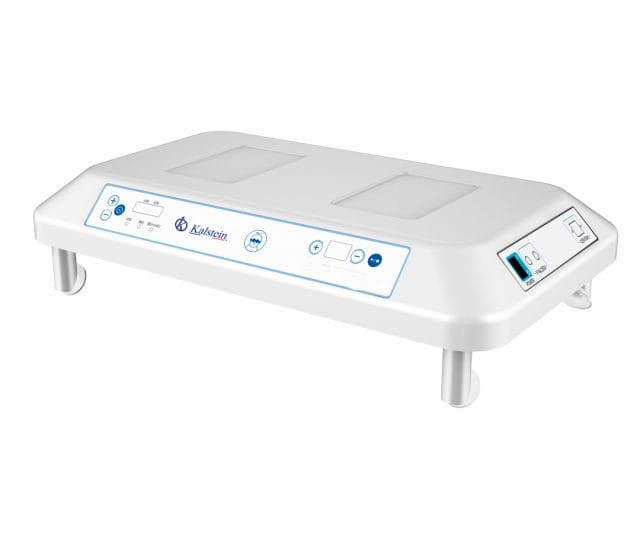Phototherapy is a form of therapy or light treatment to treat neonatal hyperbilirubinemia, a condition causing the clinical condition known as neonatal jaundice, which refers to yellowing of the skin and mucosa of newborn babies, due to excess bilirubin in blood.
Thanks to the action of light, bilirubin can be transformed into bilirubin isomers, compounds that are excreted in an easier way, so through the use of phototherapy it is possible to decrease the levels of bilirubin in blood. Hyperbilirubinaemia in newborns if not treated in time, can have irreversible consequences in children, directly affecting their nervous system, because indirect bilirubin can cross the blood-brain barrier causing cell damage.
How does phototherapy work?
Phototherapy works by lowering the blood bilirubin level or preventing it from increasing. For this, phototherapy uses light energy (light) in order to modify the shape and structure of bilirubin, turning it into molecules that can be excreted more easily even with poor normal conjugation.
Absorption of light by dermal and subcutaneous bilirubin leads to a fraction of this bilirubin experiencing several photochemical reactions, generating yellow stereoisomers of bilirubin and colorless derivatives of lower molecular weight. These products are less lipophilic than bilirubin and unlike bilirubin, they can be excreted in bile or urine without conjugation.
What should be the nursing protocol for phototherapy?
It is important to note that adequate nursing care is essential to improve efficacy and to prevent complications of phototherapy. Before starting therapy, the patient will be identified, the newborn’s handlers will be informed of what will be done, and a hand wash will be performed following the health center’s current protocols, and each of these steps will be followed:
- It is always recommended to check the operation of the phototherapy lamp first, checking that it has not exceeded the maximum number of hours of use recommended by the manufacturer.
- In order to maximize the exposure area, it is advised to strip the baby and place the smallest possible diaper. It should be noted that no cream or lotion should be used on the child’s skin as exposure to light may result in injury to the patient’s skin.
- Depending on the weight and gestational age of the newborn, it will be placed in incubator or cradle. The crib will be dressed in white sheets that will serve to increase the reflection of the light.
- Place a mask to protect the newborn from retinal damage. It is important to check every three hours the correct position of the mask to avoid eye damage and obstruction of the airway area by displacement of the protection.
- The lamp should be placed horizontally between 20 and 30 centimeters from the child’s chest, keeping the light perpendicular. Postural changes every three hours will be necessary to prevent the onset of pressure ulcers.
- Feeding the newborn will be done in the most normal way possible provided the conditions of the child allow it.
- Monitor the child’s hydration level by evaluating the child’s skin and mucous membranes.
- The patient should be closely monitored for weight, diuresis and vitals. With special relevance to temperature control, since the child may suffer from hyperthermia when exposed to the heat of light, it is important to also control the temperature of the incubator or radiant cradle to adjust it to the neonate’s need.
- Keep track of the baby’s bowel movements, number and appearance as they are altered during treatment.
- Periodic monitoring of the blood bilirubin level of patients; whenever a blood sample has to be removed, the lamp must be switched off, as the light can degrade the sample by obtaining unreal altered values.
- In relation to the parents or guardians of the child, the affective bond with the child will be provided at all times and emotional support will be provided during the admission, resolving, in an empathetic way, any doubts that may arise.
- Whenever possible and depending on the child’s condition, parents will be allowed to feed the child by taking advantage of these moments to strengthen their emotional bond.
What does Kalstein offer you?
Kalstein is a company MANUFACTURER of medical and laboratory equipment of the highest quality and the best technology at the best PRICES in the market, so you can make your PURCHASE with us, knowing that you have the service and advice of a company specialized in the field and committed to provide you with safe, economical and effective options for the performance of your functions in the right way. This time we present our Child bilirubin phototherapy unit YR02194. This equipment has the following characteristics: HERE
- LED fluorescent lamp as radiant elements of phototherapy.
- The curing angle of the lamp can be adjusted horizontally.
- The height of the lamp head can be adjusted.
- The stainless steel bracket can be adjusted.
- Wheels can be locked
- Timer to record the phototherapy operation.
- Use in incubators, irradiant heat moses and any type of moses.
- Widely applicable in all hospitals and clinics and optimized for babies with jaundice.
For more information we invite you to take a look at: HERE


